Updated: June 4, 2018
Time to step away from the Ubuntu family and explore some other other distros. On the menu today, Tux Libre, with a side dish of Fedora and fresh garden Gnomes. Indeed, we shall be testing the latest incarnation of Fedora, the Red Hat test bunny. The two interesting things about it are: the use of the word freedom that it almost feels like an anti-war parody film and the fact it actually advertises itself as a distro for developers, plus the necessary friendly, easy and similar adjectives. But this is already a step in the right direction. It tells ordinary people they have nothing to look for here.
Still, I will do what I've always done - test software from the perspective of someone who doesn't really care for ideology, underlying architecture or finer points of Python code. It's about applications that bring valuable functionality and allow users to have fun. The Ubuntus sure didn't prove themselves worthy of this task so far, with a rather mediocre offering of LTS editions. Once upon a time, Fedora was decent, then it sort of stalled these past couple of releases, and maybe, Workstation 28 could be the Freedom Redeemer. Let's see.
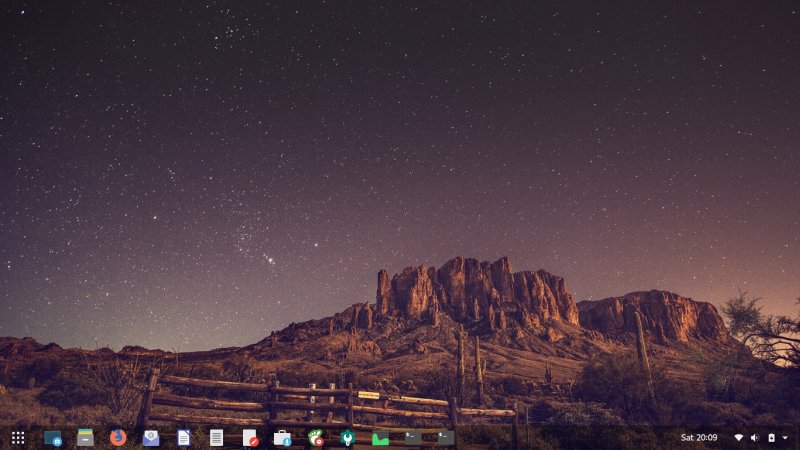
Live session
The boot sequence is fast, a combo of firmware error messages, scrolling systemd vomit, an occasional flicker of color, and not too many seconds before the Gnome desktop is reached. The Wireless functionality is hidden in the panel system area dropdown menu. The Try/Install popup was not centered - it was displayed roughly in the left third of the screen. Meh. The wallpaper is quite pretty, I have to say.

The file manager - Nautilus - looks barren and empty, and there is NO settings cogwheel to allow to you to configure the behavior, like showing folders before files. Y'know that cogwheel that disappeared from Gnome roughly two years ago (because minimalism or some crap) but that sometimes diligent readers keep on mentioning on how I'm a noob and can't use it. The icons are sad. And if you hover over a file, the hover select effect is horrible. Instead of highlighting the selected file, it's actually made paler, so it's almost invisible against the file manager background.
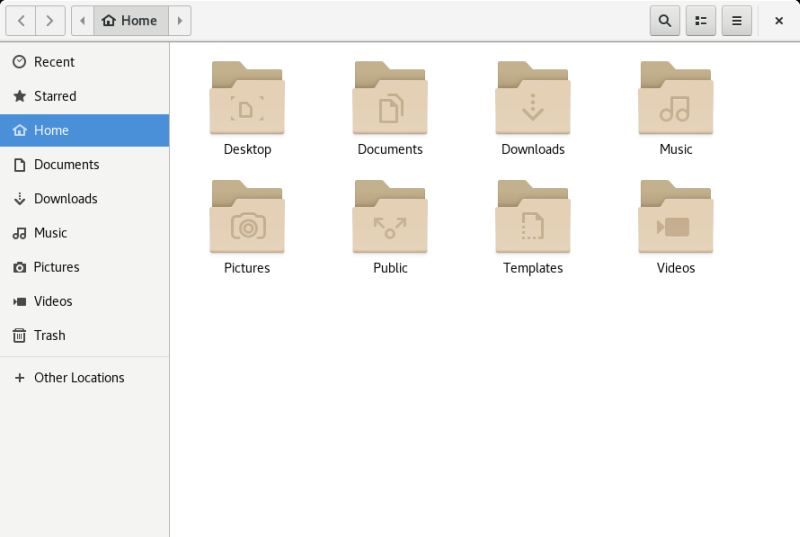
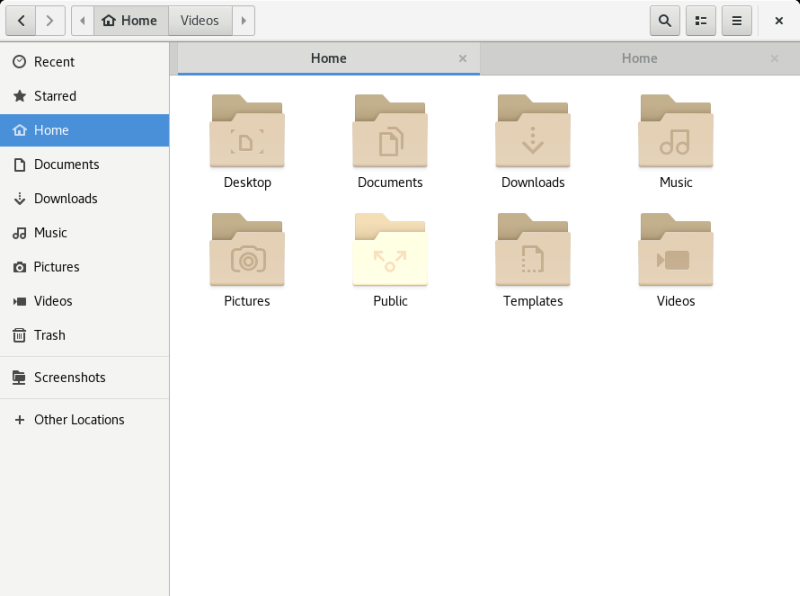
Fonts
Reasonable but not too good. When I say reasonable, I mean they are better than what we had in the past, but still not Ubuntu quality (and I mean Ubuntu, because its derivatives don't always do it well). In the past, Fedora fonts used to a big issue, and the distro plain refused to use some of the expected font AA and hinting settings and such. We shall see what gives after the installation, provided the distro behaves well enough to warrant it.

Networking
Wireless worked, all right. Samba sharing - of course not. We need the same hack as in Ubuntu, because bullshit security, the most overrated hype in the computer industry. Don't be surprised if someone decided to cancel TCP or UDP in Linux one day, because it's used to deliver viruses and whatnot. Once you change the protocol version for the client (not server, you see!), it works fine, and so does Samba printing, albeit with a somewhat slow discovery, but we can excuse that. Wireless printing also worked.


Why does the printer applet need unlock if there are no printers - and especially in the live session?

Bluetooth also behaved - with even longer discovery times. Eventually, I was able to pair my phones, but in the elapsed time, a couple of stars went supernova. Still, on the network front, we have a fairly decent behavior, and if not for Samba nonsense, Fedora 28 would have delivered a good, solid record here.


Multimedia playback
Good. HD video and MP3, nice. However, if you click on an MP3 file, Rhythmbox launches, lists all your music files in the selected directory, stalls on this listing, and then does not play the one file you actually wanted to use. Why is this useless and buggy program still here? I've been mentioning these EXACT issues for at least two years. And there's the smartphone playback, but we will get there. Also, no system area integration for either this program or Videos, but at least the latter works fine.

Stuck adding tracks.


Smartphone connectivity
Good, three out of three, excellent - Android, iPhone (iOS 11), Windows Phone. The only issue you may have is if you add the iPhone without unlocking it, it will stall on first mount, even after you unlock and trust the device, so you need to unmount/mount, but otherwise, it works fine. I was also able to play music, with correct metadata and cover art, in Videos. Predictably, Rhythmbox crashed on this operation - with the same bug that's been around for three years. The program simply needs to be removed, it serves no purpose.



And music:

And Rhythmbox sadness:
[ 1006.250163] rhythmbox[4448]: segfault at 30 ip 00007f1540baa8a6 sp 00007ffca31760f0 error 4 in libmtpdevice.so[7f1540b9d000+16000]
Installation
Some things never change - and the ergonomic calamity that is Fedora's "new" installer is one of them. It still remains one of the most horribly designed pieces of software, which makes this digital sin even greater because it handles such a delicate part of the system setup. Going back to the top left corner to "approve" actions is like looking for a steering wheel behind the rear seats in a car.

I had to select both the root partition as well as /boot/efi (UEFI/GPT) setup, otherwise the installation will fail. But it's so easy to make a mistake and format this critical little device. The Ubuntus don't need this, they handle it automatically, and I don't understand why Fedora (or any other distro like this) needs manual pointing to the EFI partition. Swap wise, too, if you don't format the swap partition, it won't be mounted in the installed Fedora. Completely unnecessary. In this regard, openSUSE is lightyears ahead, and it remains the safest installer in the universe.
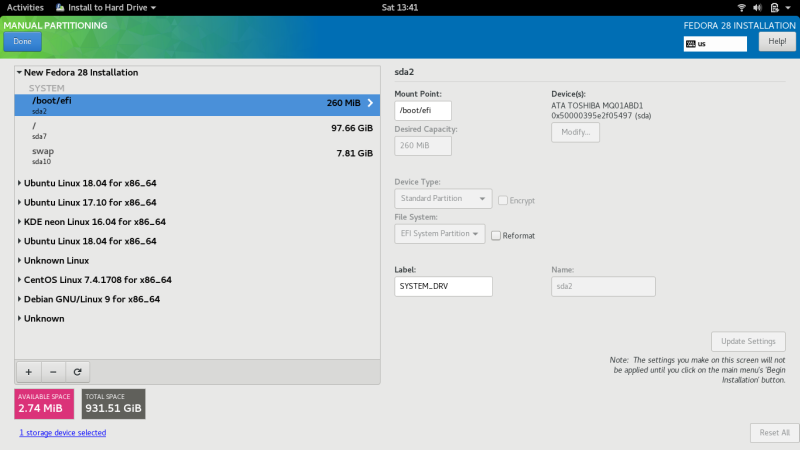
Language wise, I selected En (US), so let's see what happens here, and if Fedora is going to force some localization nonsense on me like the Ubuntus. Then, there's the actual installation, which was neither too fast nor too slow, but the little box that sort of shows you "slides" of information is so ugly I punched my knee twice. The supposed content does not even fit into the box. ALL HAIL THE QA GLORY OF LINUX!!!!



And this is, children, why developers should NEVER EVER be allowed to design a product.
Using Fedora 28
The distro installed fine. First, no problems with the multi-boot setup - the whole initrd error thingie we saw in the past. Second, the boot sequence still remains fast (if colorfully challenged), 2-3x faster than most other recent distros on this particular box. I guess some of the systemd stuff can actually be optimized, go figure. Third, the language was correctly set! Fourth, the Wireless network settings were also preserved from the live session. So many tiny differences between distros, it's actually quite disheartening.Initial setup
However ... before you get to see the desktop, there's the second stage of the installation, where you get to configure your user and such. In the past, this was done before the first reboot, but now, you have a complete separation, which probably allows Fedora to be shipped as an OEM system. Anyway, you get to configure your user, no root and no sudo questions, online accounts, geo-location and automatic problem reporting, and a few other small things.
I tried taking screenshots - and the desktop did make camera shutter noises, but these screenshots were not preserved. Also, I find it ironic that Fedora sets location services to ON by default, and everyone's so mad about Ubuntu for wanting to use system diagnostics and such. In fact, lots of distros actually uploaded your lspci output back in the mid-2000s, and no one complained about spying.
Online accounts is an interesting one, we shall talk about this a while later.
Package management & updates
Gnome Software behaves slightly differently in Fedora than other systems. For the first time ever, it will actually prompt the user if they want to search third-party repos for proprietary content. This is a major improvement, and a huge step forward from the ideological stance that serves no useful purpose. But it's also a paradox, because Fedora is meant to be a dev-focused distro, so why would the devs need Steam or Skype or not be able to command-line their way forward? So is this distro meant to be for devs or ordinary folks then?


Wow, Steam actually shows in Gnome Software. Finally, after roughly 4-5 years, the program might actually be usable. Small steps for mankind, big steps for whatever.
This implementation is incomplete, though. Enabling third-party through Gnome Software will make the search and relevant contents only available through the GUI. You won't get any results on the command line, and you will need to manually download and install RPM Fusion Free and Non-free repos if you want the extras.
The updates worked fine. There were lots of them, too. The system did not notify me, I used dnf from the command line. The updates were fast, too, but the framework maxed the system resources. The desktop was sluggish, completely, totally, while the update process was running. This is very intrusive.


System behavior while running updates.
After the reboot, the system did finally notify of some more updates - and I also had a kernel crash. I mean really. I've just updated the distro, and the first thing is some nonsense in the kernel? So sad and utterly pointless.
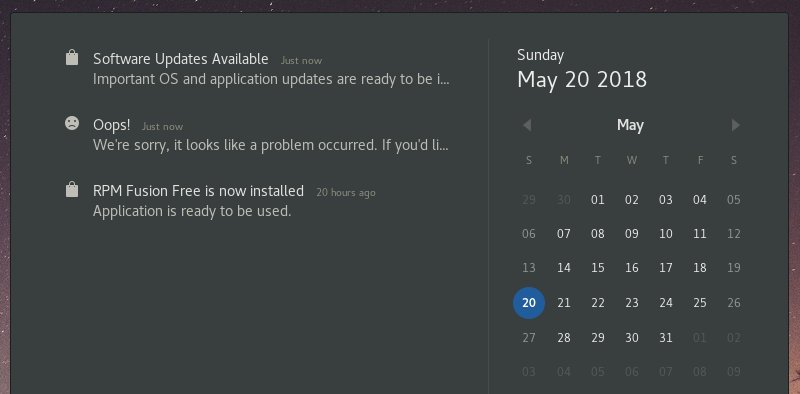

Applications
Fedora 28 weighs approx. the same as a contemporary Ubuntu, and it also gives you about as much when it comes to default software. The collection is reasonable and practical - Firefox, Evolution, LibreOffice, Videos, Rhythmbox, Cheese. And then you can get the extras fairly easily. I installed VLC, Steam and GIMP from the RPM Fusion repos, and added Skype and Chrome locally with dnf from the command line.
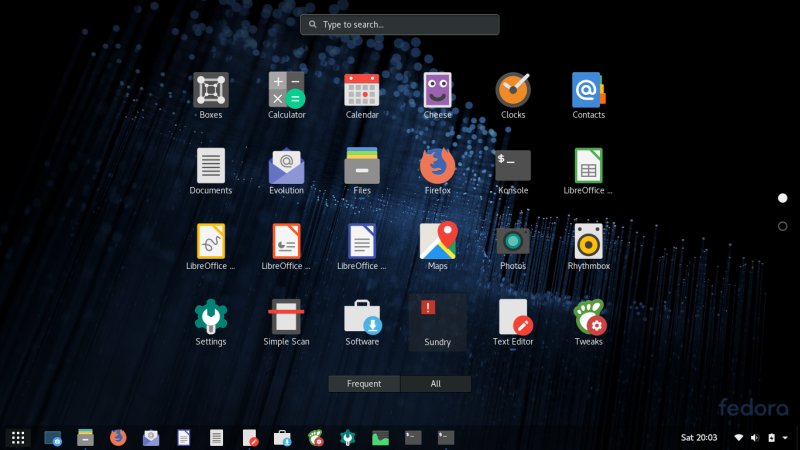

Why are some apps dark and some not? More high-quality QA.
Customization
Gnome 3 is useless in its default form. It embodies a pseudo-touch minimalism idea that mistakes visual minimalism for functional minimalism. First, Linux needs to actually carve some percentage of desktop usage, and then we can talk about mobile devices. The concept is premature. And also horrible for desktop users, because they get overlarge apps with kindergarten interfaces, little to no functionality. Look at Windows 10 apps, if you need another data point. Literally every single Metro app or Modern app or whatever they are called is totally inferior to their classic desktop counterparts. Those apps work well on the mobile, really well, but not so on the desktop. And when have you last seen Gnome used on a phone? Exactly.
I spent a lot of time trying to make Fedora 28 usable - and then realized I was wasting precious time on making a pointless idea manageable. This is fine to show what I've done in my review and provide pointers to people seeking help with the Gnome 3 desktop, but actually, this is a futile exercise.Nautilus - it does not list folders before files. You can change this using dconf or dconf-editor, a glorified registry editor for Gnome, which of course isn't installed by default. So you need an extra program, and a super nerdy one at that, to do something that every other operating system in the world does well and easily.

I tried the Breeze-gtk theme, only to find out that some Gnome apps don't work well with this theme. Any Gnome app that uses the Adwaita Dark theme by default (a horrible inconsistency of its own) like Cheese, Boxes or Gnome Terminal simply stopped being usable with my customization. And why would there actually be any apps that use the dark theme when the desktop is actually set to use the light theme (by default)? This is another QA nonsense, and it's been around for a good few years.


Any app that is hard-coded to Adwaita Dark does not like non-default themes.
Then, I invested time in grabbing Gnome Tweak Tool, enabling Gnome extensions, which itself is a convoluted and useless process, installing several new extensions like Dash to Panel and Media indicators, new icons, and a new wallpaper. You have to use jpg files and place them in your Pictures folder or Gnome won't be able to find them. Yes, Gnome 3 is that flexible.
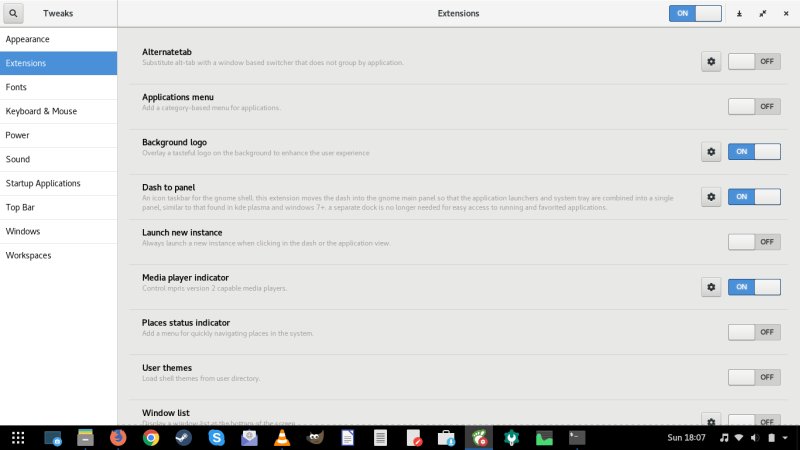
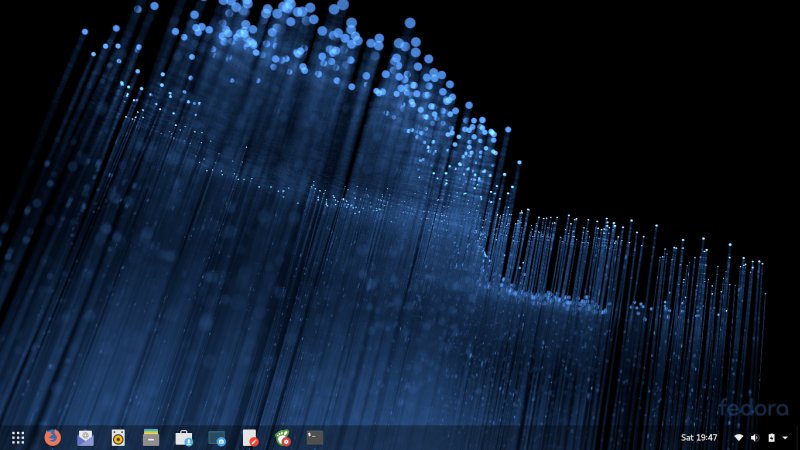
KDE apps didn't always integrate well into the panel (D2P). I had Konsole added, but then it also showed as a separate app window. I guess there's more needed here to make Gnome accessible, should you actually care. All in all, it was a somewhat frustrating adventure.

Slowly but surely improving:

Desert night wallpaper from wallhaven.cc.

Fonts
I wasn't happy with the defaults. Fedora also uses grayscale AA, which isn't the best choice. I decided to try the AA & hinting tricks that didn't yield any results in the past.
gsettings set org.gnome.settings-daemon.plugins.xsettings hinting slight
gsettings set org.gnome.settings-daemon.plugins.xsettings antialiasing rgba
echo "Xft.lcdfilter: lcddefault" > ~/.Xresources
This time, BOOM! The changes actually worked. A logout-login later, I had crisp, pleasant, usable fonts. Freetype-freeworld is no longer available as a package in the repos, and freetype is already installed by default, so there may have been a major change to the font backend, which also allows the settings above to take effect. My only question is, why aren't these settings enabled by default?

Online accounts
If there's one thing that Gnome does seemingly well, it's the online accounts functionality, which is another hint to its pseudo-touch identity crisis. But you have more options than other desktop environments, and this is actually supposed to work. I decided to configure a Microsoft account - the test one I often use for my Microsoft Office Online tutorials among other things. The account was added. I could actually see my online documents displayed in the Gnome Documents app. However, calendar, email and contacts were NOT synced, and these apps did not actually show the online part at all. When I clicked on the online thingie in the Calendar, it actually opened the Online accounts tool again. In Contacts, nothing happened. We will talk about this more when I review Gnome 3.28 separately. Stay tuned for that.


Hardware compatibility, suspend & resume
All in all, it was good. Fedora has some new features, like Thunderbolt support, but they are not applicable to my setup. What hardware I have, it worked fine. Webcam, Fn buttons, suspend & resume. There are no issues there. Stability was good, apart from the kernel oops and the occasional app borking up.
Resource usage, performance
This is an interesting one. First, numbers. Raw memory figure on idle, 1.7 GB, which a lot. Much more than Ubuntu, and almost 4x more than Kubuntu 18.04, for instance. CPU danced at about 5-6%, which does not seem much on its own, but then the responsiveness is bad even without anything happening.

The performance was awful. The distro was slow. Gnome 3 has never been lean or efficient, but it's now become completely useless. Even moderate multi-tasking would cause perceptible slowness and lag. There are no smooth transitions between programs. Menus and app windows close with a visible delay.
The infamous Gnome memory leak also seems present. Within less than hour from a fresh reboot, the memory utilization had spiked to double the initial value (which isn't low), but I suspect it was much higher, because swap was also in use. CPU utilization was 30-40% on two cores! I rarely if ever see swap used during normal day-to-day sessions. What's worse, this is a 2015 Lenovo G50 laptop with an i3 processor, four logical cores and a very decent 8 GB RAM, and yet, it was stuttering and struggling more than my old LG RD510 machine from 2009, the other test box that I often use, running pretty much any other desktop environment.

There's nothing much running in the background really.
I wanted to restart the Gnome session to see if this helps, but of course, you cannot do this under Wayland, which happens to be another glorious modern-day technology designed to be complex and dev-friendly, much like systemd. I had to log out, chose Xorg, then logged back in, and the memory usage was now down to about 1.8 GB, and the system was actually usable. So I guess the fix still hasn't propagated from Gnome 3.30 down to this edition, or whatever. The fact this was allowed into an official release is like releasing a starved honey badger into an orphanage.

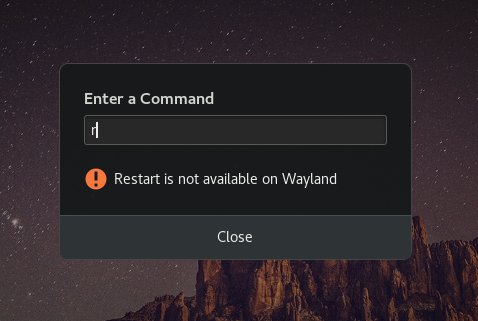
And people wonder why Ubuntu didn't want this for their LTS.
Battery life
With brightness set to 50% and the battery charge at 80% max. capacity, the value of about 3 hours sounds quite impressive, because that translates into almost 4 hours for a fresh battery, which parallels some of the best results we had on this machine. But only 15 minutes into light to moderate usage, the value was down to about 1.5 hours at 85% charge (or roughly 65% original capacity). This means 2.5-3 hours at a stretch, but still better than most Ubuntus. I really wonder if anyone actually bothers working on power management, or if this turns out to be a magical twist of random luck.
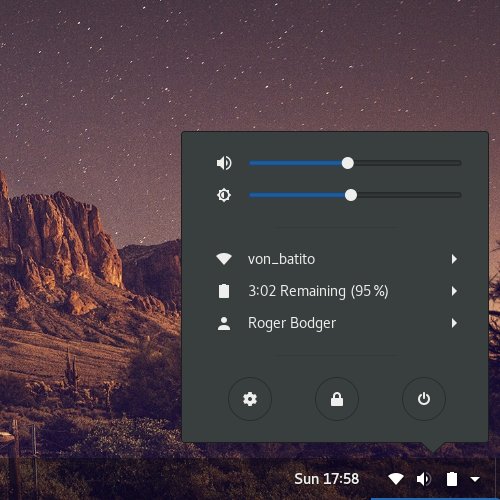

Other observations
Despite memory leaks, awful performance and such, the laptop's disk was never hot, not even in the live session. I guess the Gnome environment is so inefficient that it doesn't even let the disk become the actual and expected bottleneck.Gnome Software keeps refreshing every 10 seconds or so. Laggy and annoying. SELinux was quiet, and it did not intrude into the session, but there was an odd error in the messages here and there. Gnome Documents also segfaulted once.
[ 586.049189] gnome-documents[3595]: segfault at 8e28 ip 00007fc34be8a844 sp 00007ffdc5a4a028 error 4 in libmozjs-52.so.0.0.0[7fc34ba49000+bd4000]
[ 1434.738489] SELinux: Context
unconfined_u:unconfined_r:sandbox_t:s0-s0:c0.c1023 became invalid (unmapped).
[ 1435.829775] SELinux: Context system_u:unconfined_r:sandbox_t:s0-s0:c0.c1023 became invalid
(unmapped).
Gnome apps have a non-uniform windows size - the top border is different, sometimes thinner, sometimes fatter, but I couldn't find any real pattern apart from the obvious bad QA and random development in isolation. There's no utility to install hardware drivers - can't be done through Gnome Software. No Skype integration icon, and no suitable extension.
Still needs checking ...
Well, I do intend to test Fedora 28 - not because it really justifies it, because I'm thorough - on the old LG laptop with its Nvidia card. I want to see if Gnome Software will allow for a simple installation of graphics drivers, and if we're going to have the same color issues like in the past - one of the color channels not showing under Nouveau, everything being fine under Nvidia, part of that new hype in having the blue light channel changed or such to supposedly protect the dreams of late-night users. A non-medical bullshit fad.
Conclusion
Fedora 28 is buggy, riddled with problems and that awful performance issue, some good and brilliant points, and it takes a lot of hard work to tame and put into order. In other words, it's a perfect toy for the typical developer, I guess. For ordinary folks, the good points of being able to play music, connect phones and find nice software are definitely appreciated. But they are more than offset by Gnome 3 being useless and hard to make less useless, inadequate default font settings, tons of visual inconsistencies, occasional app and kernel crashes, and dreadful performance and resource utilization.
This distro makes sense as a test bed for software, nothing more. It is not suitable for day-to-day use, and there are too many problems. I find this sad, because RHEL and CentOS are the exact opposites of this equation, and that means a person interested in a Red Hat distro for their home use will probably have to compromise in some way. All in all, worth checking, but it's a tinkerer's trinket, not a system for serious use. None of the spring crop seem to be. Anyway, feel like testing, go ahead. But I still find the older 24/25 releases to have been much better. 4/10. Take care, freedom fighters.
Cheers.